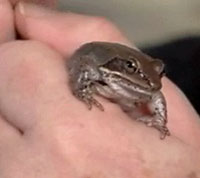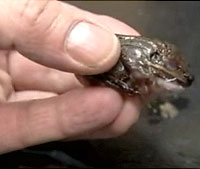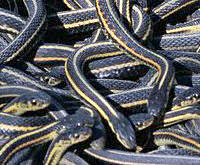
On this page, you'll find regularly updated audio, video, and text reports from our producers and correspondents. We invite you to join the discussion about topics covered here on our board and to subscribe to our audio and video podcasts to download these reports to your computer or MP3 player.

To see a video clip of a wood frog squirming in my hand, click on the image above. 
Just how frozen is this frog? To take a look at a video clip, click on the image above. |
2.24.2005 Frozen SolidPeople who know about frogs know about this. Or some of them do. But I'm betting you don't. There is a frog—a little frog about the size of my thumb—that lives in North America. It's called a wood frog. And typically that's where you'll find it: in the Ohio woods, the western Pennsylvania woods, woods around the Great Lakes, and woods up in Saskatchewan. And when the woods run out further north and it's all tundra and bushes, these frogs can be found there too, even north of the Arctic Circle. So it's a frog that's used to getting cold. And that's where this gets interesting. Most frogs, come winter, will burrow down into the mud or the earth or the pond bottom to get away from the cold. They will spend the winter months hibernating or doing very, very, very little. Not our guy. In chilly October and November, he's still hippity-hopping along among the leaves searching for food. But at the first frost—the first time our frog encounters ice—just the touch of ice on his skin starts off a wild set of changes. The ice triggers a bunch of chemical messengers, hormones that race through the frog's body, and, depending on the temperature, things can happen very quickly. First, water migrates from the frog's middle—from its blood, heart, lungs, liver, and other central organs—and forms a puddle just under the skin. So the middle of the frog is getting drier but the area near its skin is getting wetter. Then, over days or within hours, the puddle of water turns to ice. Solid ice. So solid you can pick up the frog in your hands and tap it on a desk and it feels like a block of ice. (I'm not saying you should do this, only that if you did you'd be astonished.) Rock solid. Like an ashtray. Want to see this? I'm not going to drop the guy or do anything violent, but when you look, you'll see: he's frozen. Check out the video clip at left. Inside, the frog is virtually dead. No heartbeat. None. No circulation. No liver function. No kidney function. His eyes are white, frozen over. And he can stay like that (gals too; I should say he or she) for weeks and months. This animal survives the winter, living on the forest floor, by becoming a cold rock. So the question we will ask in the next episode of NOVA scienceNOW is: What happens in the spring? How does something that has totally stopped (and I mean totally) start again? Consider these problems:
So, if I've gotten you curious, remember, the next NOVA scienceNOW will air where you live on April 19, 2005 at 8 p.m. ET. Our frog will be there, waiting.
By the way: For those of you who want to see other animals come to life in the
springtime, may we suggest a trip to Winnipeg in Manitoba, right in the middle
of Canada, where in May, if you drive north on Highway 17, you could
see—we kid you not—10,000 GARTER SNAKES EMERGING FROM THE SAME PIT!
Well, it might not be 10,000; it might be 7,000 or 8,000, but when that many
snakes appear in the same place, who's counting? Not us. Who's screaming with
delight? Us. These aren't, after all, poisonous snakes. There are just lots and
lots and lots of them. For more information, check out
www.naturenorth.com/spring/creature/garter/snake1.htm
|
|||||||||||

Robert Krulwich is the host and executive editor of NOVA scienceNOW. He is also a correspondent for ABC News, reporting for ABC World News Tonight, Prime Time Live, Good Morning America, and Nightline. He contributes regularly to National Public Radio. Krulwich has explored the structure of DNA with a banana, illustrated the Texaco-Pennzoil battle with Barbie and Ken dolls, and demonstrated a video game by driving around in a car with Connie Chung. For nearly three decades, Krulwich's reports have made economics, technology, and science funny, entertaining, and comprehensible. Krulwich lives in New York City with his wife and two children. |
||||||||||||
|
© | Created February 2005 |
||||||||||||
